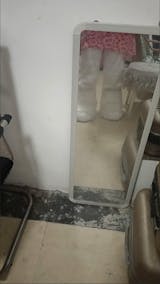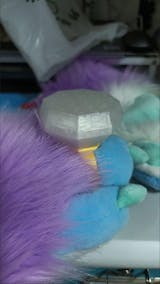For fans of Japanese-style furries and DIY creators alike, building your own Kemono fursuit head can be an exciting and rewarding project. With their oversized eyes, soft expressions, and anime-inspired aesthetic, Kemono-style fursuits are a favorite among cosplayers, convention-goers, and creators who crave a cuter, more stylized look than traditional Western suits.
In this complete tutorial by MeowFursuits, you'll learn how to design and construct a Kemono head from scratch—including base building, eye construction, shaping, and furring. Whether you're a beginner or improving your technique, this Kemono fursuit DIY guide will help you bring your character to life.
What is a Kemono Fursuit?
Kemono is the Japanese word for “beast” or “animal,” but in the furry fandom, it refers to a specific, stylized art form rooted in anime culture. Kemono fursuits feature large, glassy eyes, small muzzles, rounded features, and exaggerated cuteness that blends animal traits with human-like expressions.
Unlike Western-style fursuits, which often focus on realism or cartoonish exaggeration, Kemono fursuit head designs aim to be soft, approachable, and charming—perfect for cosplay photography and performances.
Tools & Materials Checklist
Before we start, gather the following essential items. High-quality materials will ensure your Kemono fursuit DIY project is comfortable, durable, and beautiful.
Tools:
- Utility knife or hot wire foam cutter
- Scissors
- Hot glue gun (low-temp preferred)
- Sewing kit or sewing machine
- Fabric chalk or pens
- Measuring tape
Materials:
- High-density upholstery foam (1”-2” thick)
- Balaclava (for wearable comfort)
- Mesh or plastic canvas (for eye frames)
- Buckram or clear plastic (for eye whites)
- Acrylic paint or Copic markers (for eye detail)
- Faux fur in chosen colors
- Fleece or minky fabric (optional for facial details)
- Elastic straps or helmet base (optional for support)
Step 1: Planning Your Kemono Fursuit Head Design
A successful fursuit head design starts with careful and thorough planning. Before you pick up any tools or cut any foam, it's crucial to have a clear vision of your design. First, sketch out your character from multiple angles (front, side, and 3/4 views) to create a comprehensive visual guide to inform every decision during the build process. This step helps ensure that proportions, shapes, and details remain consistent throughout the build.
Before cutting any foam, it's essential to plan your Kemono fursuit head design. Start by sketching your character from multiple angles—front, side, and 3/4 view. This visual map will guide every construction decision.
Key Design Questions
- What species is your character?
First, determine the species of your character, as this will influence key features such as ear shape, muzzle length, and facial structure.
- What emotion or personality should the face express?
Next, think about the personality or emotion you want your fursuit head to express—should it convey friendliness, curiosity, or mischief? These emotional cues will shape eye placement, mouth shape, and even fur patterns.
- Will your eyes be static or follow-me style?
Another critical decision is the style of the eyes. Will you opt for static eyes that remain fixed in place, or choose follow-me eyes that move with the wearer’s head, adding lifelike expressiveness? Deciding this early affects both the design complexity and the mechanical build.
- What colors, markings, or textures define your character?
Lastly, define your character’s color scheme, markings, and texture preferences. These elements add uniqueness and personality to your suit but also introduce additional challenges during construction.
For first-time builders, MeowFursuits recommends starting simple—choose a single base color with minimal markings and perhaps an open-mouth smile design. This approach allows you to focus on mastering the core construction techniques without being overwhelmed by intricate patterns or complicated facial features.
By investing time in detailed planning, you'll have a smoother, more enjoyable build process, ultimately producing a furry head that truly embodies your vision.
Step 2: Building the Base Structure
Creating a sturdy and well-shaped base is essential for a durable and comfortable Kemono fursuit head. This foundational step determines how your head will fit, balance, and hold its shape during wear. Depending on your experience and desired level of support, you can choose between two main methods to construct the base: a foam-only base built on a balaclava or a helmet core reinforced with foam.
Option 1: Foam Base on a Balaclava
The most traditional and versatile method involves starting with a snug-fitting balaclava placed on a foam head stand or mannequin. This provides a flexible yet stable platform to build upon. Begin by cutting foam blocks carefully and gluing them to form the basic facial features—cheeks, brow ridge, muzzle, and the back of the head. Temporary pins or clips can be used initially to test the placement and proportions of each piece before committing with glue. This approach allows you to adjust the shape as needed, ensuring a comfortable fit and the correct silhouette.
- Start with a snug balaclava on a foam head stand or mannequin.
- Cut foam blocks and glue them to build up the cheeks, brow, muzzle, and back of the head.
- Use temporary pins or clips to test placement before gluing permanently.
Option 2: Helmet Core (for added stability)
For builders who want extra structural support and durability, using a lightweight bike or construction helmet as the core base can be advantageous. This helmet core offers a solid framework to attach foam layers, which you then sculpt to achieve the desired head shape. The helmet also helps distribute the weight more evenly, which can improve comfort during extended wear. It’s important to keep in mind ventilation and visibility—make sure to leave adequate openings or create vents so the wearer can breathe easily and maintain good sightlines.
- Use a lightweight bike or construction helmet as a base.
- Add foam layers around the helmet to sculpt the desired shape.
No matter which base-building method you choose, taking the time to carefully construct a well-fitted foundation will pay off throughout the rest of your fursuit head project, resulting in a professional and wearable final product.
Step 3: Shaping the Foam Base
This is the most creative part of your Kemono fursuit head construction—shaping the foam base into a lively, expressive face that captures your character’s personality. Shaping the foam base requires precision and patience, as the contours you carve will determine the face's personality and overall expression. With the right tools and techniques, you can shape a rough block of foam into a smooth, vivid shape that captures the signature softness of the Kemono style.
Tips for Shaping
- Start large, then refine the details.
Begin by carving away large sections of foam to establish the general shape and proportions of the head. Resist the urge to dive straight into fine details. It’s easier to gradually refine the form than to fix over-carved areas. This broad-to-fine approach helps maintain balance and symmetry throughout the process.
- Constantly check for symmetry.
Symmetry is crucial for a polished and professional look. Use a mirror frequently to view your work from different angles, or take photos to spot uneven areas that the eye might miss in person. Consistent comparison between the left and right sides ensures your fursuit head has that clean, balanced appearance characteristic of Kemono designs.
- Smooth the surface carefully.
After rough shaping, use sandpaper or a sanding block to gently smooth out any harsh edges or bumps. Soft, flowing contours are key to achieving the gentle, approachable aesthetic typical of Kemono fursuits. This sanding process also helps prepare the surface for attaching fur and other materials.
Pay special attention to shaping the cheeks, brow ridge, and muzzle to embody the classic Kemono look. The cheeks should be rounded and full, creating a youthful, friendly expression. The brow ridge should be gentle and soft rather than angular, avoiding harsh lines. The muzzle is typically smaller and more tapered than Western-style fursuits, enhancing the stylized, anime-inspired appeal.
By carefully sculpting these elements, you breathe life into your fursuit head, laying the groundwork for the final stages of detailing and fur application.
Step 4: Creating the Eyes and Expression
The eyes are the soul of any fursuit head. They draw attention and reveal the character's personality at a glance. Kemono designs emphasize large, expressive eyes, making careful eye crafting essential to bring the fursuit to life. The right eye construction can turn a flat mask into a vibrant, emotional character.
Follow-Me Eye Technique
- Cut eye frames from mesh or plastic canvas. These provide a structural base while allowing visibility.
- Paint or draw irises directly onto white buckram fabric, leaving the pupils semi-transparent for visibility and depth. Glue these layers to form a gently domed eye shape that mimics an eyeball.
- Insert the completed eye assemblies into your foam base with meticulous alignment to ensure balanced and expressive gaze. Use temporary fittings before final adhesion to avoid cross-eyed or vacant stares.
- Add finishing touches such as eyelids and lashes to shift expressions from playful to serious or shy. Optionally, incorporate LED lights behind the eyes for a glowing effect at nighttime events or photoshoots.
- Soften the areas around the eyes and muzzle using plush fabrics like fleece or minky, adding tactile warmth and complementing the gentle Kemono contours for a comfortable, inviting feel.
Investing time in creating well-crafted eyes anchors the fursuit head’s expression, making your Kemono character truly stand out.
Step 5: Furring Your Kemono Fursuit Head
Furring your Kemono fursuit head can be daunting, but with preparation and proper techniques, it becomes one of the most rewarding steps. Proper fur application brings your character to life visually and defines the tactile quality and durability of your suit.
Steps:
- Make duct tape patterns from the foam head.
- Transfer patterns to faux fur, shaving as needed for contour.
- Cut fur with a craft knife (not scissors!) to preserve fibers.
- Glue or sew fur onto the head, starting from the center outward.
Use a slicker brush and blow-dryer on low heat to fluff and blend seams. Choose high-quality fur with good pile direction for best results.
Step 6: Final Assembly and Finishing Touches
After all the hard work of shaping, detailing, and furring your Kemono fursuit head, it’s finally time to bring everything together in the final assembly stage. This step is crucial for ensuring that your head not only looks amazing but also fits comfortably and functions well during wear.
Final Checklist:
- Eye alignment and ventilation
- Chin strap or elastic for secure fit
- Inside padding for comfort
- Painted or airbrushed details for depth
At MeowFursuits, we suggest adding a name tag, hidden fan (optional), or removable tongue for easy cleaning.
Care Tips and Storage
To make your fursuit head last, proper care is essential:
- Brush regularly with a slicker brush
- Spot-clean with pet-safe detergent
- Store in a breathable bag, away from sunlight
- Avoid heat and compression during storage
Final Thoughts and Next Steps
Congratulations! You’ve completed your own Kemono fursuit DIY project—and hopefully learned more about shape, structure, and style in the process. Whether you plan to wear it to conventions, photo shoots, or social media videos, your suit is a reflection of your artistic voice.
Here at MeowFursuits, we’re proud to support the DIY community with guides like this one. From offering kits and patterns to showcasing creators on our platform, we’re committed to helping you design the most adorable, high-quality Kemono fursuit head possible.
Ready to build your next character? Browse our supplies and custom services to make your dream design come to life.















